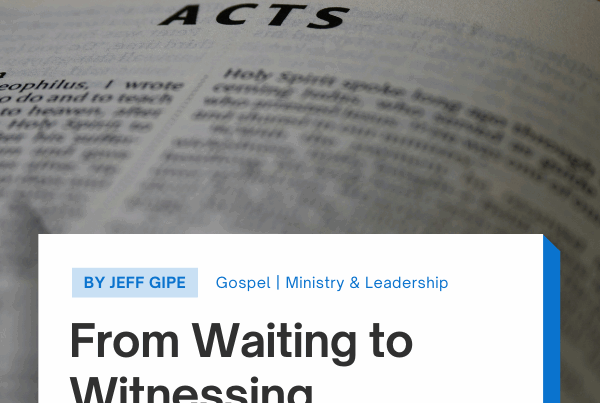
When looking for a New Testament model for church leadership in the early church, we find a plurality of elders. Nowhere in the New Testament do we find a board of elders.
All believers in a city were called “the church.”
The believers in each city were called the church of that city.
• The church in Jerusalem (Acts 8:1)
• The church in Corinth (I Cor. 1:2)
• The church of the Thessalonians (I Thess. 1:1)
• The church in Corinth (1 Cor. 1:2)
• The churches of Revelation (Rev. 2,3)
A Plurality of Elders Oversaw the Church in Each City
A plurality of elders (also known as overseers/bishops or pastors – Acts 20:17-28), led each church.
• In Acts 20:16-17, Paul called the elders (plural) of the church (singular) of the Ephesians.
• In Titus 1:5, Paul instructed Titus to appoint elders (plural) in every city (singular) of Crete.
• In 1 Timothy 5:17, Paul referred to “the elders (plural) who rule well” at the church (singular) at Ephesus.
The Early Church Met in Small House Groups
The church did not assemble all together in a building. We find them
meeting in house churches.
• Fellowships met in the houses of Aquila and Priscilla in both Corinth (I Cor. 16:19) and Rome (Rom. 16:3,5).
• In Rome, an assembly also met at the house of Gaius (Rom 16:23).
• The households of Aristobulus (Rom. 16:10) and Narcissus (Rom. 16:11) as well as the two groups mentioned in Romans 16:14,15 were also probably house churches.
• The church in Laodicea met in the house of Nymphas (Col. 4:15).
• A church met in the house of Philemon (Philemon 1:2).
• The meeting at Lydia’s house probably indicated it was a place of fellowship (Acts 16:40).
The term “church” designated not only the whole network of assemblies in a community, but also each house church in that network was called “church.”
Each House Church Had an Elder
• Each of these house fellowships had a leader who was designated the elder. In secular literature, the term “overseer/bishop” (episkopos) always designated an administrator, who had his own area of administration. These overseers did not make group decisions.
• In listing qualifications of leadership, Paul uses the singular word “overseer” (episkopos, 1 Tim. 3:2) but the plural word “deacons” (diakonoi, 1 Tim. 3:8).
• When Peter asked the elders to “be shepherds of God’s flock that is under your care, serving as overseers” (1 Pet. 5:2), he spoke to a culture that knew how shepherds functioned. Each night, the shepherds would bring the flocks together into the night enclosure. During the day, each shepherd took his personal flock out to pasture.
The Elders Did Ministry Together
• Elders prayed for healing (James 5).
• They laid hands on men for service (Acts 15:22; 1 Tim. 4:14).
• They worked together to “refute” those who opposed sound doctrine (Titus 1:9; Acts 20:30-31).
While we have no record of elders coming together to talk and make decisions about ministry, they did cooperate to do ministry.
But what about the Jerusalem Council in Acts 15? In Acts 15, we find apostles and elders functioning as a large council (not a church board). This council was under the strong leadership of James. When the decision was made, James said, “Wherefore I decide,” (dio ego krino ) with an emphasis on the “I.” Though he had consulted with the council, his decision became the decision of the group (Acts 15:19).
The Overseer of Elders
From the earliest days of the church, one elder was recognized as having authority over a network of churches in a given place. He was the overseer of the other elders. Each of these overseers had only one geographical church under his authority — not a group of churches. These included:
• Clement of Rome ( -99 AD) was seen as the bishop overseeing the house churches in Rome.
• Ignatious (ca. 35/50 – ca. 110 AD) had oversight over the Christians in Antioch.
• Polycarp (69-155 AD) oversaw the church at Smyrna.
• Timothy (ca.19 – ca. 97 AD) became the overseer of the church of Ephesus. At some point, John the Elder (probably the apostle) assumed that duty.
Ignatious and Polycarp overlapped the apostolic age and made it clear that their doctrine and practice were in line with the apostles. They were never accused in their days of introducing new practices that led the church away from apostolic order.
Origin of the Board Form of Eldership
Can anyone give evidence that elders ever functioned as a decision-making board before John Calvin? John Knox studied under Calvin and carried the eldership concept back to Scotland in 1559. The Scotts were rebelling against all things monarchial English. This new approach to church government fit in with their desire to get away from the hierarchy of the English church.
Some observations about the plurality of eldership:
• If we seek to reduplicate the exact form of church government of the early church, we need to go back to house churches, each with an overseer.
• Throughout Scripture, God exercised leadership through an anointed man. In the Old Testament, God raised up man after man, beginning with Moses and then with the judges and kings. Later, the apostles each had their own place of influence.
• The board form of church government is not strictly a group of equals each carrying the same weight. One or two of the members will usually dominate the group, and the others will more or less go along with him/them. So, you come back to a single leader, but rather than God’s anointing, it will be by force of personality.
• For good growth in a board-led church, the pastor needs credibility, so that the board let’s him lead rather than making him follow.
Eldership Today
The culture of the early church was that of intense persecution. That led to the house churches. We are not under the same persecution, so do we need to retain a church structure for persecution survival? Nothing in Scripture mandates that we follow that pattern for church government.
Our congregations are larger than house churches. So do we base our government on individual house churches as a model? Or do we look at the citywide network of house churches as the model?
Either way, it appears that the house church had a single leader, and the network of churches had a leader.









